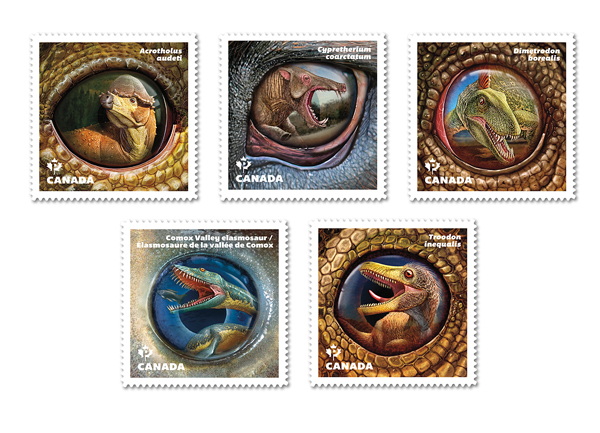May 26, 2016
Posted in News Releases
Predator or prey? There’s more than meets the eye in Dinos of Canada stamp sequel
May 26, 2016
Posted in News Releases

OTTAWA – The mystery about the prehistoric creatures depicted in Canada Post’s exciting new Dinos of Canada stamp series is whether they are the hunters or the hunted.
The series, unveiled today, depicts five beasts from Canada’s geological past as reflections in the eyes of their prey or the predators stalking them. They are vividly illustrated by Sergey Krasovskiy, one of the world’s top paleo-artists.
The stamp design team at Vancouver’s Subplot Design Inc., led by Roy White, created an interesting storyline for the stamps with each eye as its unique frame. The stamps inspire the imagination without having to depict an entire scene.
The repeating eye motif comes roaring back on the uncut press sheet as the eye of a hungry tyrannosaur and as the frame for a single stamp among seven other souvenir sheets.
The creatures’ fossils were found across Canada and represent vastly different geological times. The animals were chosen with the help of the Canadian Museum of Nature, which assisted in the development of the 2015 series. They are:
- Acrotholus audeti – This small dinosaur possessed a skull bearing a 10-centimeter thick dome of solid bone over the eyes. The bipedal herbivore may have used the dome to butt heads with other members of its species. It inhabited the then coastal lowlands of Alberta about 85 million years ago.
- Comox Valley elasmosaur (this fossil has not yet been given a scientific name) – The vicious marine reptile had a neck nearly seven metres long that helped it hunt its prey 83 million years ago. It was discovered in 1988 by a father and his 12-year-old daughter prospecting for fossils in the Comox Valley.
- Cypretherium coarctatum – One of a group of mammals commonly known as “terminator pigs,” this fearsome beast had a long, narrow snout with menacing pointed teeth at the front. It lived on the ancient floodplains of Saskatchewan 35 million years ago.
- Dimetrodon borealis – Heralded upon its discovery as Canada’s first dinosaur, paleontologists later came to realize it was a mammal-like reptile. Its fearsome jaws were filled with serrated teeth and it likely used a sail on its back for display. It lived in what is now Prince Edward Island about 270 million years ago in, when it was hot and dry and located near the Equator.
- Troodon inequalis – The bird-like dinosaur was similar to the carnivorous Velociraptor of Jurassic Park movie fame. It had the largest brain of any dinosaur in relation to its body size and was a resident of Alberta’s coastal lowlands about 75 million years ago.
About the stamps
The four-colour stamps measure 40 mm x 40 mm. They are available in booklets of 10 permanent stamps printed by Lowe-Martin. The uncut press sheet measures 480 mm by 650 mm and features an enlargement of a tyrannosaur, whose eye is the frame for a single stamp among seven other souvenir sheets. Each souvenir sheet measures 159 mm by 105 mm and consists of five stamps. The cancel image on the Official First Day Cover features dinosaur tracks. The cancel site is Courtenay, B.C., where the Courtenay and District Museum and Palaeontology Centre is home to the Comox Valley elasmosaur.
For more information:
Media Relations
613-734-8888
medias@canadapost.ca